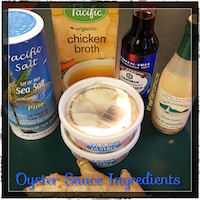Oyster Sauce
by
INGREDIENTS:
INSTRUCTIONS:
- Start by putting broth on to bring it up to a boil.
- While it starts heating, rinse oysters really well in cold water. I use a sieve because I find them too slippery to hold securely.
- Once they are well-rinsed, put them in the broth. You don’t have to wait for it to boil.
- Coarsely chop about 2″ of average-thickness ginger. Oh, and don’t peel it, just rinse it if you are worried about cleanliness of the skin. Add ginger to the broth.
- Add soy sauce, clam juice, and salt to the broth.
- Bring it all up to the boiling point, then turn it back down to a gentle simmer. On my stove that’s around 3-1/2, where 9 is Hi.
- Simmer it gently for about 45 minutes, until the broth has a nice deep, rich brown colour to it.
- Strain the broth into a container, and either prepare to store the oyster sauce, or rinse the saucepan and return the strained broth to the stove for the next two optional steps.
- OPTIONAL: If you want to thicken it up like store-bought oyster sauce, which I used to do when I first started making my own but never bother with now, simply mix in some tapioca starch until you get it to the thickness you like. If you thicken it, then you can use quantities that are suggested by recipes. If you don’t thicken it, then you might need to add more to your recipe to get the same flavour.
- OPTIONAL: If you want it to be slightly sweet like store-bought oyster sauce, something I never do and never miss, you can add a Tablespoon or two of a safe sweetener of your choice, such as cane sugar… (I now find white beet sugar leaves a bit of a bitter aftertaste, and never use it anymore). Honey might be nice, too, but I’ve never tried it.
- Storage: I pour it out into 1/2 cup amounts and put them in the freezer to keep handy for use in recipes such as Tofu and Bok Choi.
IMPORTANT:
- BROTH: Choose your broth carefully to ensure it is corn- and wheat-free. Look for ingredients such as cornstarch, citric acid, caramel, the word “vegetable” that doesn’t include a specific list of which vegetables (e.g. “hydrolyzed vegetable protein”), and anything that suggests wheat. All that said, I always make my own from scratch.
- CLAM JUICE: Choose very, very carefully to find one that doesn’t contain any citric acid or other corn-derived ingredient. This can be tough to find, so when you do find it, encourage your store to keep carrying it. I went through a period of a couple of years when the “safe” brand I used to buy disappeared, and I had to manage without any, which makes a big difference to the final result. I did try adding a little fish sauce to make up for it, but wow, that stuff is salty! Now I’ve found one again, and I’ll post it in the Grocery section so you can look out for it too, or try to get your store to bring it in.
- SOY SAUCE: Alcohol-based varieties are likely made with either corn or wheat, while wheat-free tamari sauce often lists generic “alcohol” on the ingredient label, so proceed with caution. I’ve found a very traditional alcohol-free variety that I’m having great success with now, which I’ll have to share soon. If you can’t have soy, coconut aminos should do the trick; just leave out the optional sweetener entirely.
- SALT: Iodized salt usually also contains corn in very small amounts to keep it from clumping. “Free-running” on the label is a big avoidance clue, along with “iodized.” You probably already know which salt is safe for you.
- BROWN SUGAR: If you want to try this for your sweetener, proceed with great caution. I’m not sure if there’s a difference between Canadian brown sugar and American or British/European, but I’ve not had any troubles with it here in Canada while I have read cautions about the American varieties. This is a topic I’ll have to research more.
EA’s NOTES:
I’ve long forgotten what store-bought oyster sauce tastes like, but I really like this version that I’ve arrived at over many years of experimentation. If you like onions, you can also add two or three chunks of the white sections of scallions (aka green onions) to the broth with the ginger, and if you like garlic you can add two crushed cloves then, too. However, I really like it best without either; this way, you can add the “right” amount of garlic and/or onion to your dish without the risk of overdoing it with the sauce you add in at the end, too.
Also, this might sound crazy to some people, but I LOVE eating the strained-out oysters at the end of the sauce-making exercise. I don’t like raw oysters at all, so this might sound disgusting to people who do appreciate them fresh from the ocean, but I find myself getting impatient for the sauce to finish simmering so I can dig into a nice warm plate of tasty oyster meat covered in chunks of ginger. Heh. As my Irish mother used to say, “To each his (update: or her) own!”

